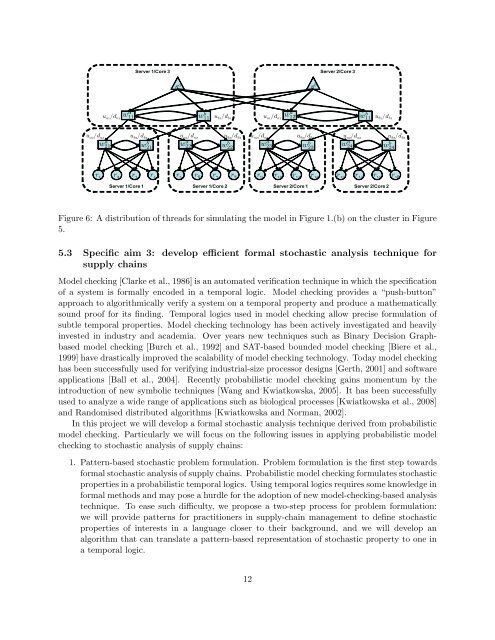SimRisk: An Integrated Open-Source Tool for Agent-Based ...
SimRisk: An Integrated Open-Source Tool for Agent-Based ...
SimRisk: An Integrated Open-Source Tool for Agent-Based ...
You also want an ePaper? Increase the reach of your titles
YUMPU automatically turns print PDFs into web optimized ePapers that Google loves.
Server 1/Core 3<br />
Server 2/Core 3<br />
s a<br />
s b<br />
u a1 /d a1<br />
w11 a w11<br />
b u w12 a w11<br />
b b1 /d b1 u a1 /d a1 u b1 /d b1<br />
u a2 /d a2 u b2 /d b2 u a2 /d a2 u b2 /d b2 u a2 /d a2 u b2 /d b2 u a2 /d a2 u b2 /d b2<br />
w a 21 w b 21<br />
w a 22 w b 22<br />
w a 23 w b 23<br />
w a 24 w b 24<br />
r 1 r 2 r 3 r 4 r 5 r 6 r 7 r 8 r 9 r 10 r 11 r 12 r 13 r 14 r 15 r 16<br />
Server 1/Core 1 Server 1/Core 2 Server 2/Core 1 Server 2/Core 2<br />
Figure 6: A distribution of threads <strong>for</strong> simulating the model in Figure 1.(b) on the cluster in Figure<br />
5.<br />
5.3 Specific aim 3: develop efficient <strong>for</strong>mal stochastic analysis technique <strong>for</strong><br />
supply chains<br />
Model checking [Clarke et al., 1986] is an automated verification technique in which the specification<br />
of a system is <strong>for</strong>mally encoded in a temporal logic. Model checking provides a “push-button”<br />
approach to algorithmically verify a system on a temporal property and produce a mathematically<br />
sound proof <strong>for</strong> its finding. Temporal logics used in model checking allow precise <strong>for</strong>mulation of<br />
subtle temporal properties. Model checking technology has been actively investigated and heavily<br />
invested in industry and academia. Over years new techniques such as Binary Decision Graphbased<br />
model checking [Burch et al., 1992] and SAT-based bounded model checking [Biere et al.,<br />
1999] have drastically improved the scalability of model checking technology. Today model checking<br />
has been successfully used <strong>for</strong> verifying industrial-size processor designs [Gerth, 2001] and software<br />
applications [Ball et al., 2004]. Recently probabilistic model checking gains momentum by the<br />
introduction of new symbolic techniques [Wang and Kwiatkowska, 2005]. It has been successfully<br />
used to analyze a wide range of applications such as biological processes [Kwiatkowska et al., 2008]<br />
and Randomised distributed algorithms [Kwiatkowska and Norman, 2002].<br />
In this project we will develop a <strong>for</strong>mal stochastic analysis technique derived from probabilistic<br />
model checking. Particularly we will focus on the following issues in applying probabilistic model<br />
checking to stochastic analysis of supply chains:<br />
1. Pattern-based stochastic problem <strong>for</strong>mulation. Problem <strong>for</strong>mulation is the first step towards<br />
<strong>for</strong>mal stochastic analysis of supply chains. Probabilistic model checking <strong>for</strong>mulates stochastic<br />
properties in a probabilistic temporal logics. Using temporal logics requires some knowledge in<br />
<strong>for</strong>mal methods and may pose a hurdle <strong>for</strong> the adoption of new model-checking-based analysis<br />
technique. To ease such difficulty, we propose a two-step process <strong>for</strong> problem <strong>for</strong>mulation:<br />
we will provide patterns <strong>for</strong> practitioners in supply-chain management to define stochastic<br />
properties of interests in a language closer to their background, and we will develop an<br />
algorithm that can translate a pattern-based representation of stochastic property to one in<br />
a temporal logic.<br />
12




